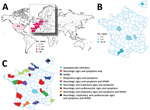Volume 25, Number 6—June 2019
Dispatch
Multirecombinant Enterovirus A71 Subgenogroup C1 Isolates Associated with Neurologic Disease, France, 2016–2017
On This Page
Downloads
Altmetric
Stéphanie Tomba Ngangas, Alexander Lukashev, Gwendoline Jugie, Olga Ivanova, Jean-Michel Mansuy, Catherine Mengelle, Jacques Izopet, Anne-Sophie L’honneur, Flore Rozenberg, David Leyssene, Denise Hecquet, Stéphanie Marque-Juillet, David Boutolleau, Sonia Burrel, Hélène Peigue-Lafeuille, Christine Archimbaud, Kimberley Benschop, Cécile Henquell, Audrey Mirand, and Jean-Luc Bailly
Abstract
In 2016, an upsurge of neurologic disease associated with infection with multirecombinant enterovirus A71 subgenogroup C1 lineage viruses was reported in France. These viruses emerged in the 2000s; 1 recombinant is widespread. This virus lineage has the potential to be associated with a long-term risk for severe disease among children.
Enterovirus A71 (EV-A71) comprises 7 genogroups (A–G) and various subgenogroups (e.g., B0–B5, C1–C5) (1). B4, B5, and C4 viruses circulate mainly in Asia, and C1 and C2 viruses have been detected in Europe (2). In 2016, an upsurge in neurologic manifestations of enterovirus infection was reported in France (3). These cases were associated with an emerging lineage of subgenogroup C1 enteroviruses first reported in 2015 in Germany and later in Spain and 4 other countries (Figure 1, panel A) (4–8). Our aim was to obtain the full genomes of the viruses from the specimens collected in France and track down the origin of this emerging lineage, hereafter referred to as C1v2015.























.png)











No hay comentarios:
Publicar un comentario